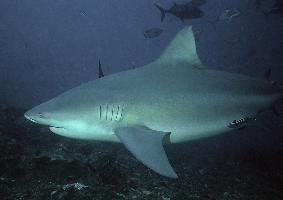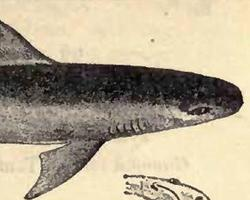
Descrierea animalului
The Bull shark (Carcharhinus leucas), often recognized for its stout body and aggressive nature, is a fascinating species of shark found in warm, shallow waters around the world. This species is notable for its remarkable adaptability, capable of thriving in both salt and fresh water, a trait that distinguishes it from most other sharks. Bull sharks are commonly found along coastlines, in river mouths, and occasionally travel far up rivers. Their presence has been recorded in freshwater locations as diverse as the Mississippi River in North America, the Amazon River in South America, and the Zambezi River in Africa.Adult Bull sharks typically reach lengths of 7 to 11.5 feet (2.1 to 3.5 meters) and can weigh up to 500 pounds (230 kilograms), with females generally being larger than males. They have a robust, broad body with a short, blunt snout, which is where their name "Bull shark" is derived from. Their skin is a grey color on top, transitioning to a white underside, which helps them blend into their aquatic environment from both above and below.
Bull sharks have a powerful bite, attributed to their strong jaws and a broad array of serrated, triangular teeth that are designed to grasp and tear through their prey. Their diet is opportunistic and varied, consisting of fish, dolphins, birds, and even other sharks. Their tendency to hunt in shallow waters has contributed to their dangerous reputation among humans.
One of the most intriguing aspects of the Bull shark is its reproductive system. They are viviparous, meaning they give birth to live young instead of laying eggs. A female Bull shark can give birth to litters ranging from 1 to 13 pups after a gestation period of about 10 to 11 months. The young sharks are born in freshwater or brackish nurseries, which offer protection from predators and abundant food sources, allowing them to grow before venturing into open waters.
Despite their fearsome reputation, Bull sharks, like many shark species, face threats from human activities. They are hunted for their fins, meat, and skin, and are often caught as bycatch in fisheries targeting other species. Additionally, their habitats are being degraded by pollution, coastal development, and climate change, which can affect their nursery areas and overall survival.
Conservation efforts for Bull sharks involve improving their habitats, implementing fishing regulations to prevent overfishing, and raising public awareness about their importance in marine ecosystems. Understanding and protecting this species is crucial, as they play a vital role in maintaining the health and balance of their environments by controlling the populations of their prey.
In summary, the Bull shark is a resilient and adaptable predator, capable of living in a wide range of aquatic
Harta răspândirii

Animale similare
Fotografii noi cu animale
Top 10 animale
- Dolphin gull (Leucophaeus scoresbii)
- Diana monkey (Cercopithecus diana)
- Moustached guenon (Cercopithecus cephus)
- Greek tortoise (Testudo graeca)
- Stone loach (Barbatula barbatula)
- Galápagos tortoise (Geochelone nigra complex)
- Japanese macaque (Macaca fuscata)
- Russian tortoise (Testudo horsfieldii)
- Common flying dragon (Draco volans)
- Galápagos penguin (Spheniscus mendiculus)


